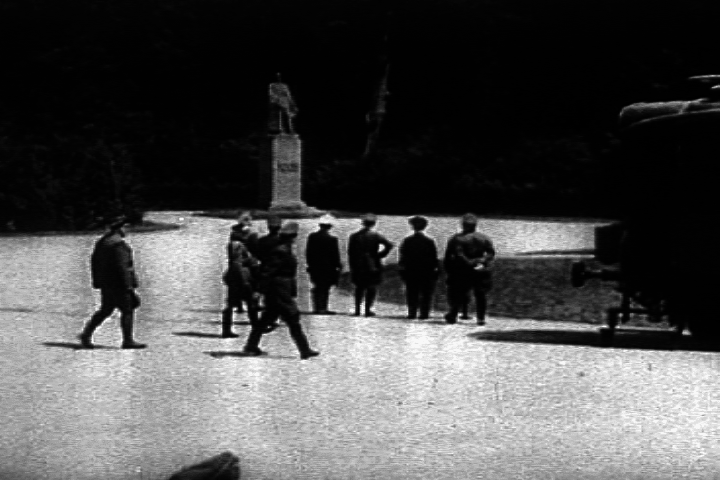

When France asked Germany to open negotiations for an armistice and peace treaty during the Battle of France, Germany was quick to agree — but Hitler had one petty and symbolic gesture that he demanded be part of any negotiations.
The rail car that had belonged to French Marshal Ferdinand Foch on display in the 1920s. It would later be dragged back into the forest on Hitler’s demand as a final insult to the conquered French army.
(Library of Congress)
He wanted the rail car of French Marshal Ferdinand Foch to be returned to Compiegne Forest and for all negotiations to be held there. The rail car and the forest were the site of Germany’s capitulation to France in 1918, ending World War I. For Hitler, this was a chance to wreak symbolic revenge for Germany’s losses, adding insult to injury of the country he had largely conquered.
Foch was a French hero in World War I. Despite setbacks in some offensives, like the Battle of the Somme for which he lost prestige, he was credited as one of the primary contributors to the plans that won the first and second battles of the Marne. By the end of the war, he was the Supreme Allied Commander and the Marshal of France.
It was in this role that he went with his train car to the Compiegne Forest in 1918 to oversee the start of the armistice negotiations. After the reading of the preamble, Fochs stepped outside in what was seen as a direct insult to the German officers within.

French Marshal Ferdinand Foch, second from right, and other officers from the French and German forces stand outside Foch’s rail car following the end of armistice negotiations ending hostilities in World War I. The armistice went into effect six hours later.
Some of the Treaty of Versailles most restrictive clauses were drawn from the armistice negotiated in the train car. Foch asked for the farm and got everything. Well, except for the exact number of submarines and locomotives he had demanded. Germany simply had less equipment than Foch desired, but they did sign over what they had.
When it was signed, Foch reportedly refused to shake the German officers’ hands. Instead, he said in French, “Well, gentlemen, it’s finished. Go.”
And it didn’t end there. While some of the worst items from the armistice were left out of the Treaty of Versailles, Foch took a public stance on wanting the most restrictive terms possible on Germany, calling for territory to be remitted to France and decades of occupation. Other negotiators and Allied government leaders refused, largely due to worries that strengthening France too much at the expense of Germany could lead to conquest by France.

French and German soldiers, mostly German, look at the Ferdinand Foch Railway Car in June 1940 as the officers prepare to sign the armistice that will withdraw most French forces from World War II.
For his part, Foch thought the final terms of the treaty were too lenient and declared that the final deal was, “not peace. It is an armistice for 20 years.”
Hitler and other German leaders, apparently still seething from their drubbing and Foch’s treatment at the end of World War I, invaded France less than 21 years after the Treaty of Versailles was signed.
During the invasion, France, gambling heavily that the Ardennes Forest was impassable for panzers and that the Maginot Line was nearly unassailable, sent its best units north. But while the Maginot Line would largely hold for a few weeks, panzers actually found fairly easy passage through the Ardennes, allowing the blitzkrieg to grab large sections of French territory.
The top tier units sent north, meanwhile, were unable to quickly turn and face the new threat and were largely enveloped, forcing the surrender of most of France’s strongest and most modern units. The blitzkrieg marched towards Paris, which was then declared an “Open City,” a city that has given up resisting so that it won’t be destroyed in the war.
The invasion had begun May 10, 1940. Largely because of the Ardennes gamble and the overwhelming force of the blitzkrieg, the negotiations for the armistice began less than six weeks later.
The Compiegne Forest, which Germany demanded be the site of negotiations, meanwhile had grown into a sort of park celebrating France’s World War I victory. A statue of Foch overlooked the rail car, monuments to French dead, and a large statue celebrating the defeat of Germany.

Hitler looks at the statue of Ferdinand Foch in the Compiegne Forest before going into Foch’s former railway car to negotiate France’s surrender to Germany.
(U.S. War Department)
Germany destroyed it all, except for the statue of Foch. Where it had once overlooked a forest filled with monuments to France’s victory, it now looked over only a wasteland. For the rest of the war and the first few months of peace, Foch’s statue sat largely alone in an empty forest, all other symbols of triumph stripped away.
But with the end of the war, money was gradually allocated to rebuild the monuments. The train car was burnt and destroyed by Germany in Berlin in 1945, but another car from the same train was found and rebuilt to appear exactly like the Ferdinand Foch Railway Car. It sits like its predecessor in the Compiegne Forest.
